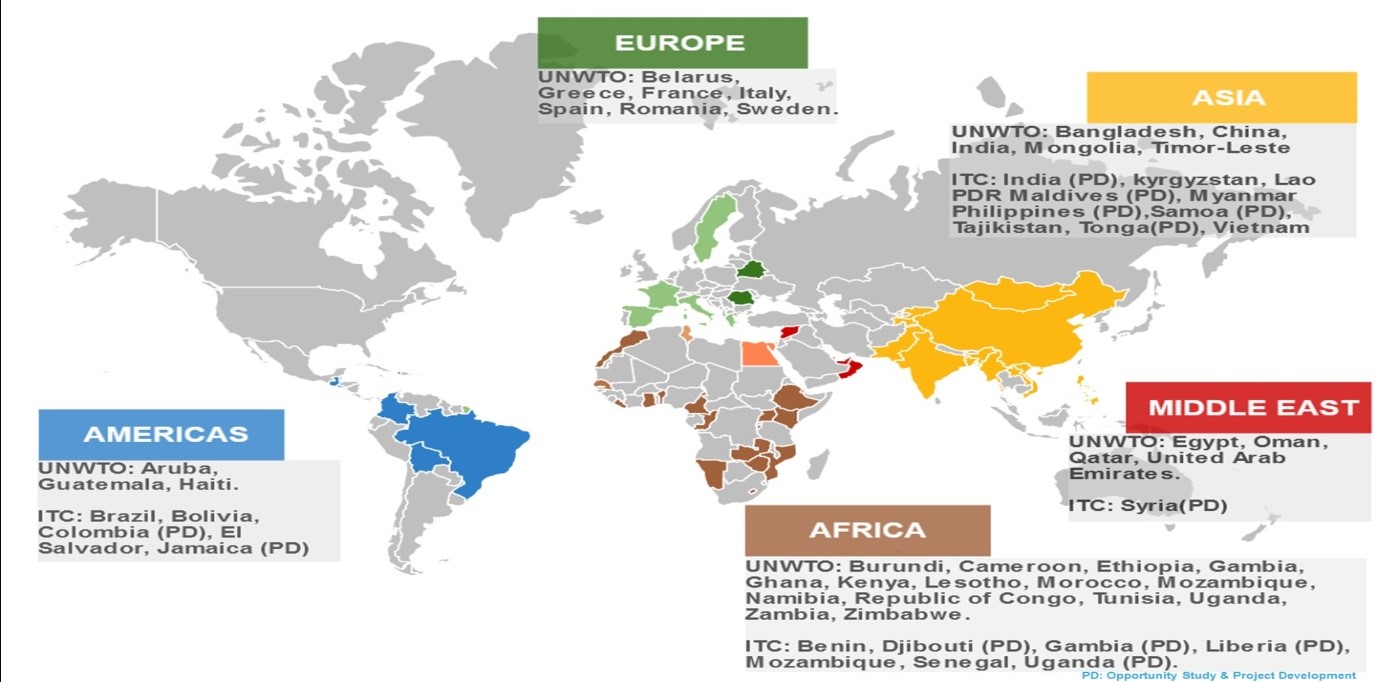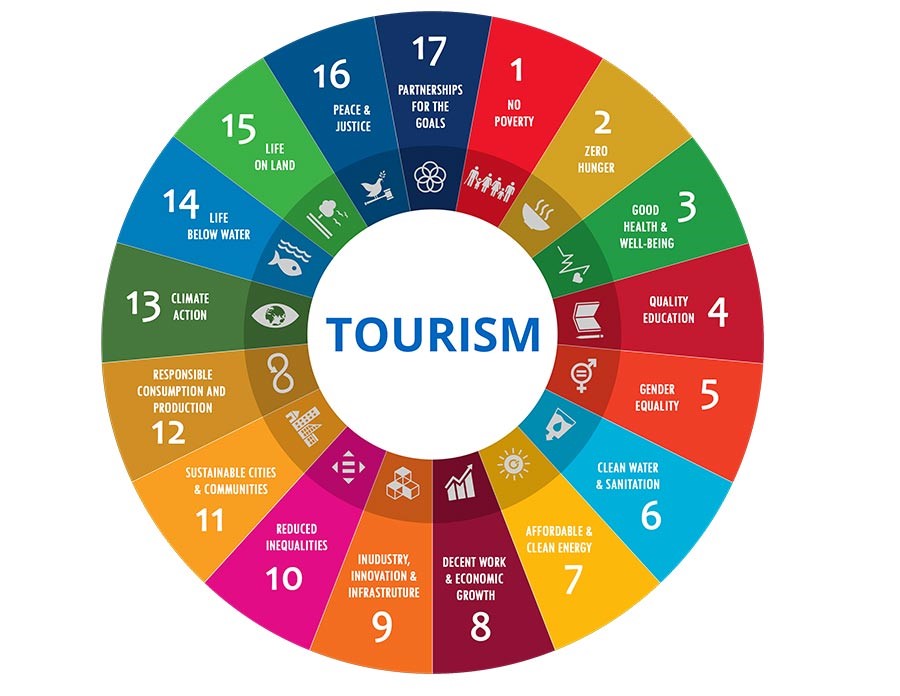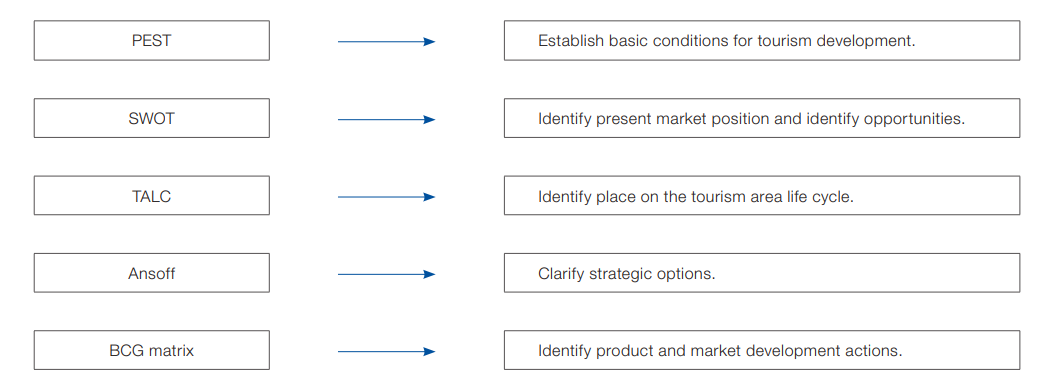TM6016 International Tourism Development Assignment Sample
Tourism Development in Eastern Africa
A sector that has great potential for development in Africa is tourism (Adeola and Evans, 2020). International tourists visited Africa in 2014 in an increase of 56 million from 26 million in 2000. Tourism revenue on the continent amounts to $36 billion, or 7% of all exports. The tourism industry in Africa is a fantastic way to encourage development and expand the continent’s contribution to the global economy.
Tourism also provides incomes for cultural and environmental preservation and provides opportunities for millions of African host communities. Therefore, it is crucial to create Africa’s capacity to develop and manage the competitive tourism industry. The development of tourism products is an essential component of the tourism industry. Tourist destinations’ competitiveness and attractiveness are determined by the range and quality of their tourism products.
 Figure 1: UNWTO Projects (Source: Tourism, 2022)
Figure 1: UNWTO Projects (Source: Tourism, 2022)
Africa’s tourism sector is becoming an increasingly important socio-economic sector, making effective strategies for developing tourism products a necessity (Hoogendoom and Fitchett, 2018). Promotional strategies that elevate the competitiveness of Africa’s tourism offer in the marketplace and address the needs and desires of prospective visitors. With the support of Casa Africa, the UNWTO Regional Programme for Africa and UNWTO Affiliate Member Program developed the present report to help African destinations increase their competitiveness in the tourism sector and an increasingly dynamic marketplace.
 Figure 2: Tourism SDGs (Source: UNWTO, 2022)
Figure 2: Tourism SDGs (Source: UNWTO, 2022)
Partnerships between the public and private sectors in Africa: a tool for development
The Tourism Highlights 2015 Edition of the UNWTO indicates that African tourism still has a lot of potentials, but only a 3% share of tourist receipts and a 5% share of international arrivals. African nations’ economic growth and job creation can be accelerated if tourism is developed effectively (Adu-Ampong, 2018). Furthermore, the sector is well-positioned to contribute significantly to the plan for social inclusion, as cultural assets and natural resources can be leveraged to provide local communities with opportunities.
It’s impossible to ignore the challenges African image faces, but a well-crafted product development plan can help alleviate the issue and improve tourism in the region. All stakeholders must participate in creating a successful tourism product for it to succeed. Different government departments and entities, as well as private companies, should be actively involved. African and Sub-African tourism destinations will benefit from the unique methodology, tools and techniques offered in this publication that will assist them in improving their competitiveness in today’s global tourism market. In general, five different analytical tools help destinations understand where they stand, what options they have for developing their tourism industry, and what marketing strategies should be used in their case.
 Figure 3: Exploring the development potential of tourism products: tools (Source: UNWTO, 2019)
Figure 3: Exploring the development potential of tourism products: tools (Source: UNWTO, 2019)
Destinations should know how they fit in the international market and how they are perceived. Analyzing different tourism product development opportunities and, based on these, setting priorities for product development are some analytical tests destinations can carry out. Destinations need to understand from the beginning:
- These countries’ political and socio-economic development is the background for tourism development. Political, economic, socio-cultural, and technological factors are considered in this analysis.
- The SWOT analysis identifies a firm’s weaknesses, strengths, opportunities, and threats.
- What stage of the tourism area life cycle they are at.
- Using the Ansoff Matrix can overcome challenges related to product development, market development, or both.
- On the Boston Consulting Group Matrix, where their existing product range fits.
Tourism product development has two primary components:
- Rather, it is part of an extensive and interrelated process that cannot be undertaken in a vacuum (Nyurenberger al. 2019).
- Marketing, product development, and market research are interconnected. The destination will not be able to achieve its full potential if these key elements are not provided.
Attracting tourists to a destination depends on the quality and range of tourism products. By establishing an overall development policy for a destination, economic and social development priorities and principles will be determined for the different sectors, including tourism (UNWTO, 2019). By understanding tourist market trends and tastes through market research, tourism product development opportunities will be identified in line with these strategies; capital investment and marketing will be required to realize the opportunities (Saner et. al. 2019).
Demand and supply are inextricably linked to the market. There can be neither without the other. There are many ways to define tourism product development: at one extreme, one can argue that it encompasses everything a visitor to a destination makes contact with, including the infrastructure.
Kenya: Case Study
With nineteen years of experience promoting transformational tourism, Campi ya Kanzi in southern Kenya has changed many lives. Besides protecting the environment and providing economic benefits to the local Maasai population, Campi ya Kanzi offers guests memorable, enriching experiences.
The camp’s mission benefits the Maasai, the wilderness, and wildlife. “Campi ya Kanzi” translates as “Camp of the Hidden Treasure” in Swahili and is named after the precious, untouched wilderness of Kuku Group Ranch. Mzima Springs, which feeds the city of Mombasa, is located in this land, which provides vital wildlife corridors and protects the water source.
Maasai Wilderness Conservation Trust partners with Campi ya Kanzi to ensure the long-term preservation of this land. Conservation efforts in Kenya are vitally dependent on Payment for Ecosystem Services (PES), which Campi ya Kanzi advocates (Kokalj, 2016). Three PES programmes are currently being developed in Kenya. In the first place, Campi ya Kanzi charges MWCT programmes such as Wildlife Pays, a compensation program that reimburses ranchers for livestock losses due to predation, with a conservation fee of USD 100 per guest per night (UNWTO, 2019).
Visitors to camp from Kenya are informed fully about the usage of these monies and play an active role in conservation. Second, as part of its REDD+ project, Kenya is assisting MWCT and other conservation groups in developing carbon credits to help preserve the Chyulu Hills forests and grasslands. The third is a tax on water from the Chyulu Hills is also being discussed between the Kenyan government and the MWC Trust to assist the MWC Trust in protecting this ecosystem.
Campi ya Kanzi protects wilderness and wildlife. It offers community support to the local Maasai community. Camp Kuku Group Ranch is owned and managed by members of Kuku Group Ranch, who are involved in every aspect of its management. Kuku Group Ranch members benefit greatly from its presence. 76 Kenyans work there – mostly Maasai – who assist with the camp’s operations and receive valuable vocational training for their families. As part of the camp, local women’s groups sell beaded jewellery to promote women’s empowerment and small business development. Campi ya Kanzi is proving that tourism is capable of changing lives.
Cape Town: Case Study
As the city of Cape Town experiences an unprecedented boom in tourism product development, fueled by market trends, a deep-seated commitment, and industry competition to responsible tourism greening and practices existing infrastructure, amenities, and attractions, the city is witnessing an explosion in innovation (UNWTO, 2019). Development in the public sector is guided by the Spatial Investment Framework and Tourism Development, which identifies key tourism staging posts, access points, and areas for development, guides public sector development.
A mobile Visitor Information service is provided using Cape Town Tourism’s mobile vehicles to place an information service in high traffic areas and seasonal hot spots based on event schedules. A built-in office is available to assist guests in booking their stay or purchasing tickets to events and shows at the original and largest Thando. Visitors can sit in local-designed chairs and use the free Wi-Fi service in the relaxing area.
Cape Town’s vehicle selection was deliberate as it boasted an eco gear manual transmission, a diesel filter, and a Blue Efficiency package that effectively optimizes fuel consumption and emissions. It is powered entirely by solar energy, showing the importance of developing tourism responsibly.
The Kirstenbosch National Botanical Garden in Cape Town was the first botanical garden in the world that was established to preserve a nation’s unique flora and is widely regarded as a masterpiece of botany. South Africa’s Kirstenbosch Botanical Garden offers visitors art, restaurants, photographic exhibits, and local favourites such as weekly concerts and markets during the summer.
One of the purposes of the development policy of a destination is to determine the direction of the destination’s economic and social development, including development priorities and principles. Market research will determine the tourism product development opportunities based on potential tourist market trends and tastes, while capital investment and marketing will be required to realize these opportunities.
Figure 4: Framework for the development of destination tourism (Source: UNWTO, 2019)
Targeted and effective marketing providers for tourism destinations and their providers of tourism products is crucial. The development of tourism products is the process of moulding assets of particular destinations to meet customer needs on a national and international basis (Richards, 2020). Some governments have long popularized the idea of public-private partnerships as a panacea to nation’s infrastructure blockages and services backlogs and a way to mitigate the problems associated with privatization.
In maximizing society’s benefits, price increases, job losses, corruption, and the sale of public assets are minimized. Nevertheless, as the experience in Africa has shown, PPPs suffer many of the same ills associated with privatization and public procurement. Privatization aims to provide a better service to citizens and reduce the burden on the state by selling underperforming government assets to private companies. Some African countries have experienced a corrupt process that has resulted in unfulfilled promises and deteriorating services. Despite inferior bids, high prices and poor expertise, relatives and friends of politicians routinely receive lucrative supply contracts.
References
Adeola, O. and Evans, O., (2020). ICT, infrastructure, and tourism development in Africa. Tourism Economics, 26(1), pp.97-114.
Adu-Ampong, E., (2018). Tourism and national economic development planning in Ghana, 1964–2014. International Development Planning Review, 40(1), pp.75-95.
Hoogendoorn, G. and Fitchett, J.M., (2018). Tourism and climate change: A review of threats and adaptation strategies for Africa. Current Issues in Tourism, 21(7), pp.742-759.
Kokalj, Ž., (2016). Green Business-A Business of Sustainability. Sage.
Nyurenberger, L., Kvita, G., Shchetinina, N. and Gromoglasova, T., (2019). The role of aesthetic component in tourism product development. Economic and Social Development: Book of Proceedings, pp.310-317.
Richards, G., (2020). Designing creative places: The role of creative tourism. Annals of tourism research, 85, p.102922.
Saner, R., Yiu, L. and Filadoro, M., (2019). Tourism development in least developed countries: Challenges and opportunities. In Sustainable Tourism: Breakthroughs in Research and Practice (pp. 94-120). IGI Global.
Tourism, (2022) [Online]. Accessed Through <https://www.intracen.org/itc/sectors/services/tourism/>. Accessed on 23rd March, 2022.
UNWTO, (2019) Affiliate Members Regional Reports, Volume four – Tourism in Africa: A Tool for Development [Online]. Accessed Through <https://webunwto.s3.eu-west-1.amazonaws.com/2019-09/AM-Regional-Report-Volume-four-Tourism-in-Africa-A-Tool-for-Development.pdf>. Accessed on 23rd March, 2022.
UNWTO, (2022) TOURISM 4 SDGS [Online]. Accessed Through <https://www.unwto.org/tourism4sdgs>. Accessed on 23rd March, 2022.
Know more about UniqueSubmission’s other writing services:


I am currently writing a paper and a bug appeared in the paper. I found what I wanted from your article. Thank you very much. Your article gave me a lot of inspiration. But hope you can explain your point in more detail because I have some questions, thank you. 20bet